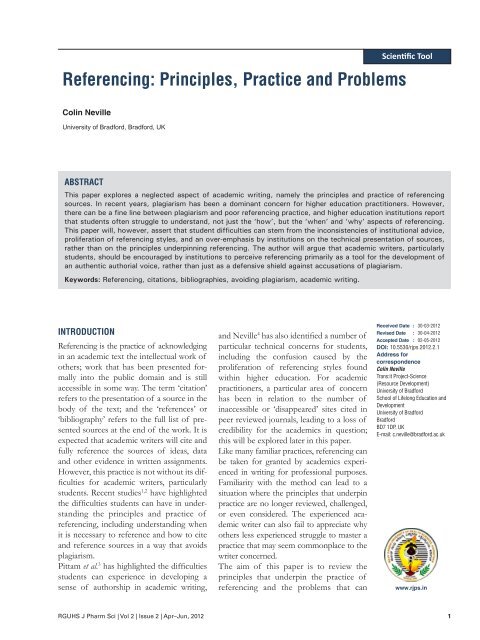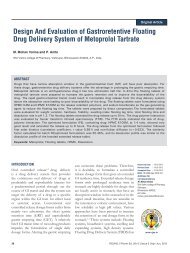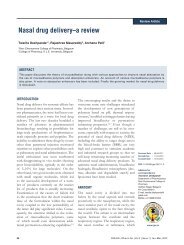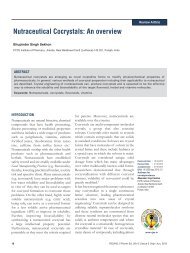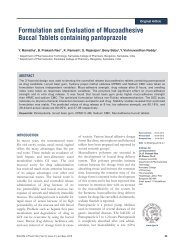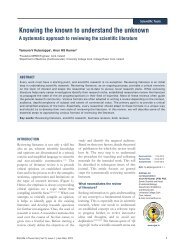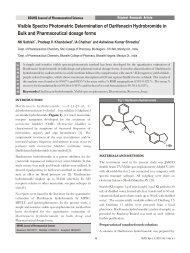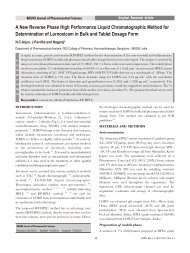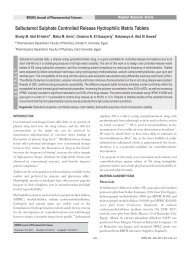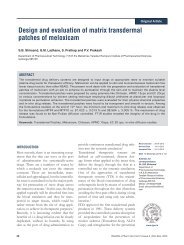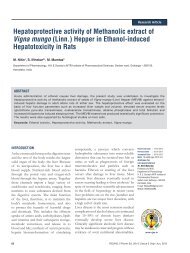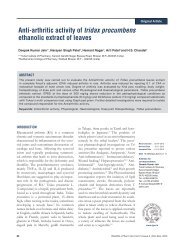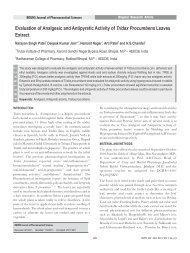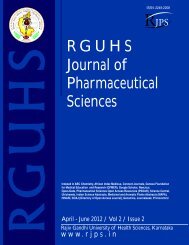RGUHS J Pharm Sci_2_2_01.pdf
RGUHS J Pharm Sci_2_2_01.pdf
RGUHS J Pharm Sci_2_2_01.pdf
Create successful ePaper yourself
Turn your PDF publications into a flip-book with our unique Google optimized e-Paper software.
Referencing: Principles, Practice and Problems<br />
Colin Neville<br />
University of Bradford, Bradford, UK<br />
AbsTRACT<br />
This paper explores a neglected aspect of academic writing, namely the principles and practice of referencing<br />
sources. In recent years, plagiarism has been a dominant concern for higher education practitioners. However,<br />
there can be a fine line between plagiarism and poor referencing practice, and higher education institutions report<br />
that students often struggle to understand, not just the ‘how’, but the ‘when’ and ‘why’ aspects of referencing.<br />
This paper will, however, assert that student difficulties can stem from the inconsistencies of institutional advice,<br />
proliferation of referencing styles, and an over-emphasis by institutions on the technical presentation of sources,<br />
rather than on the principles underpinning referencing. The author will argue that academic writers, particularly<br />
students, should be encouraged by institutions to perceive referencing primarily as a tool for the development of<br />
an authentic authorial voice, rather than just as a defensive shield against accusations of plagiarism.<br />
Keywords: Referencing, citations, bibliographies, avoiding plagiarism, academic writing.<br />
INTRODUCTION<br />
Referencing is the practice of acknowledging<br />
in an academic text the intellectual work of<br />
others; work that has been presented formally<br />
into the public domain and is still<br />
accessible in some way. The term ‘citation’<br />
refers to the presentation of a source in the<br />
body of the text; and the ‘references’ or<br />
‘bibliography’ refers to the full list of presented<br />
sources at the end of the work. It is<br />
expected that academic writers will cite and<br />
fully reference the sources of ideas, data<br />
and other evidence in written assignments.<br />
However, this practice is not without its difficulties<br />
for academic writers, particularly<br />
students. Recent studies 1,2 have highlighted<br />
the difficulties students can have in understanding<br />
the principles and practice of<br />
referencing, including understanding when<br />
it is necessary to reference and how to cite<br />
and reference sources in a way that avoids<br />
plagiarism.<br />
Pittam et al. 3 has highlighted the difficulties<br />
students can experience in developing a<br />
sense of authorship in academic writing,<br />
and Neville 4 has also identified a number of<br />
particular technical concerns for students,<br />
including the confusion caused by the<br />
proliferation of referencing styles found<br />
within higher education. For academic<br />
practitioners, a particular area of concern<br />
has been in relation to the number of<br />
inaccessible or ‘disappeared’ sites cited in<br />
peer reviewed journals, leading to a loss of<br />
credibility for the academics in question;<br />
this will be explored later in this paper.<br />
Like many familiar practices, referencing can<br />
be taken for granted by academics experienced<br />
in writing for professional purposes.<br />
Familiarity with the method can lead to a<br />
situation where the principles that underpin<br />
practice are no longer reviewed, challenged,<br />
or even considered. The experienced academic<br />
writer can also fail to appreciate why<br />
others less experienced struggle to master a<br />
practice that may seem commonplace to the<br />
writer concerned.<br />
The aim of this paper is to review the<br />
principles that underpin the practice of<br />
referencing and the problems that can<br />
<strong>Sci</strong>entific Tool<br />
Received Date : 30-03-2012<br />
Revised Date : 30-04-2012<br />
Accepted Date : 02-05-2012<br />
DOI: 10.5530/rjps.2012.2.1<br />
Address for<br />
correspondence<br />
Colin Neville<br />
Trans:it Project-<strong>Sci</strong>ence<br />
(Resource Development)<br />
University of Bradford<br />
School of Lifelong Education and<br />
Development<br />
University of Bradford<br />
Bradford<br />
BD7 1DP, UK<br />
E-mail: c.neville@bradford.ac.uk<br />
www.rjps.in<br />
<strong>RGUHS</strong> J <strong>Pharm</strong> <strong>Sci</strong> | Vol 2 | Issue 2 | Apr–Jun, 2012 1
occur, particularly for students. It will address the ‘why’,<br />
‘what’ ‘where’, ‘when’, and ‘how’ of referencing. It will<br />
also engage with the thorny issues of what constitutes<br />
common knowledge – which does not need referencing–<br />
and about the proliferation of referencing styles and<br />
the confusion this can cause to students. A key point<br />
in the paper will be that referencing difficulties of<br />
students, particularly those studying outside their home<br />
countries, are often inseparable from other the writing<br />
difficulties, and these arise largely from a lack of previous<br />
experience and knowledge of what is expected of them.<br />
One desired outcome from this paper is that institutions<br />
of higher education allocate time in staff development<br />
sessions to reviewing the way referencing is perceived,<br />
presented, and assessed.<br />
Why reference?<br />
So what is the point of referencing? It can be argued<br />
that the main purpose is to facilitate the collective<br />
development and transmission of academic knowledge.<br />
This development and transmission is powered by<br />
human endeavour and communication; referencing is<br />
one element in this communication process, and can<br />
allow writers to separate their ideas from the work of<br />
others. It also helps other scholars trace the origins of<br />
ideas, thus build links across knowledge.<br />
Secondly, all academic writers, whether students or<br />
practitioners, are expected to become more critical of ideas<br />
as they progress in their careers. This critical approach<br />
includes the intelligent selection, review, analysis and<br />
presentation of ideas in support of a chosen argument.<br />
Referencing is a practical manifestation of this engagement<br />
with knowledge and crucial in the development of<br />
authorial identity, particularly in the analysis, review and<br />
construction of arguments.<br />
In this respect, Becker 5 believes the construction of<br />
arguments is the predominant function of referencing.<br />
In Becker’s view, referencing facilitates the communication<br />
of evidence to support a particular case, or to<br />
assess, compare, contrast or evaluate different sources.<br />
Shahabudin, 6 summarising work done by the ‘Critical<br />
Thinking’ learning area of the Learn Higher Centre of<br />
Excellence in Teaching and Learning (CETL) network,<br />
also suggests that mastery of the principles and practice<br />
of referencing is an important element for academic<br />
writers in the development of critical thinking.<br />
Shahabudin 6 sees referencing as a way to gain authority<br />
and authenticity in academic writing if it is used to<br />
help to trace the origins of ideas, synthesize multiple<br />
voices in any discussion, and build a web of connecting<br />
ideas.<br />
Thirdly, it can be argued that the standardisation of<br />
referencing practice, in compliance with a particular<br />
referencing style, supports this communication process.<br />
Colin Neville: Referencing: Principles, Practice and Problems<br />
The accurate citation and referencing of sources, and in<br />
a consistent way, advances a writer’s credibility with his<br />
or her peers, and facilitates others to identify the type of<br />
source, originator, publisher, and the date of its origin.<br />
This serves to comply with copyright agreements,<br />
acknowledges the authors or originators of the work in<br />
question, and assists other academic writers with their<br />
own research.<br />
Despite the potentially broad role of referencing in<br />
academic writing, Angelil-Carter 7 found that undergraduate<br />
students in her South African study perceived<br />
its function largely in terms of satisfying institutional<br />
guidelines, and quotes one student as viewing referencing<br />
as a ‘damn nuisance’ 7 (p. 64), rather than as an aid to the<br />
development of arguments. Angelil-Carter 7 cites other<br />
examples where referencing is seen as a strategy for<br />
merely displaying reading coverage or for mimicking the<br />
conventions of academic writing, rather than a means for<br />
students to develop their ‘own voices’ in assignments. 7<br />
(p. 61) Neville 8 too, has argued that the ‘moral panic’<br />
around concerns of plagiarism in UK higher education<br />
has produced a situation where undue emphasis is<br />
placed by institutions on the ‘when’ and ‘how’ aspects of<br />
referencing, rather than on the principles underpinning<br />
referencing, particularly the development of authorial<br />
identity in academic writing.<br />
Discussion about academic integrity in general, and<br />
plagiarism in particular, has gained momentum in higher<br />
education over the last two decades, leading to policies<br />
and statements emanating from within institutions<br />
warning students of the dire consequences of plagiarism<br />
to their academic careers. However, Levin 9 and Neville 8<br />
feel that these warnings have made academic writers,<br />
particularly students, anxious about expressing their<br />
own views in assignments. Both commentators 8,9 argue<br />
that concerns about plagiarism can lead some students<br />
to adopt defensive forms of writing. This is where<br />
the identity or personality of the writer is submerged<br />
by the weight of citation and referencing in the text,<br />
including the referencing of texts included merely for<br />
‘show’ purposes, but clearly not read by the students in<br />
question. This defensive form of referencing highlights<br />
a tension many academic writers appear to feel between<br />
developing their own ideas, demonstrating their<br />
commitment to the set reading, and avoiding accusations<br />
of plagiarism.<br />
Abasi et al. 2 for example, in their study of graduate<br />
students, found that: “The students relied heavily on citation<br />
and referencing to represent themselves as writers who had consulted<br />
their sources.” 2 (p. 10) They quoted a student who said:<br />
“You don’t want to write or read a paper that is full of citations,<br />
but you have to when you are a student”. 2 (p. 110)<br />
Neville, in his study of students’ perceptions of<br />
referencing, found students who described the process<br />
2 <strong>RGUHS</strong> J <strong>Pharm</strong> <strong>Sci</strong> | Vol 2 | Issue 2 | Apr–Jun, 2012
of academic writing as akin to editing, rather than<br />
authorship. He quotes two postgraduate students: 8 (p. 28)<br />
The person is not able to bring out his own thoughts, in<br />
the fear that this idea has already been quoted by previous<br />
authors. As this process of fear grows higher, the interest<br />
to research and innovate is lost… as the reader analyses<br />
further almost every idea that [he] thinks is already quoted<br />
by another…I am not against referencing, but with the<br />
degree to which it is over-emphasized, I fear it will defeat the<br />
objective of education – to train the minds to think.<br />
“ It is considered that if there are a lot of references<br />
[in the assignment] then the person has done more<br />
research, which is not necessarily true. I think an assignment<br />
must be more of your own work, and not an entire literature<br />
review. Your own ideas and words must be valued…”<br />
This tension can lead to students writing in a way that<br />
buries their writing style identity behind a crustacean layer<br />
of referencing to the point where, as one experienced<br />
higher education tutor has suggested:<br />
“Any rhythm that the resulting prose might have<br />
possessed had been destroyed through being referenced to<br />
death.” 10 (p. 54)<br />
However, there have been interesting workshop<br />
approaches within higher education institutions to<br />
encourage students to develop their own authorial<br />
identities and to use referencing as a tool for this purpose.<br />
The University of Aberdeen, for example, has embedded<br />
academic writing workshops within its <strong>Sci</strong>ence Masters<br />
programmes. These workshops address questions, such<br />
as, ‘What is a piece of academic writing?’; ‘What is an<br />
argument?’ Feedback from students and staff has been<br />
positive, with all commenting favourably on the increased<br />
understanding and application of the conventions of<br />
academic writing. 11 At London Metropolitan University<br />
and Liverpool Hope University, Writing Centres were<br />
established, and peer mentoring schemes introduced,<br />
enabling successful post-graduate students to mentor<br />
new undergraduate and postgraduates in academic<br />
writing generally, or for a particular discipline. 12<br />
The use of plagiarism detection software, such as Turnitin<br />
and Ferret, can also be used, not just to deter plagiarism,<br />
but in formative way to assist in the development of<br />
academic writing. Barratt and Malcolm, 13 for example,<br />
report on a study involving 182 mainly postgraduate<br />
International Masters students on Computer <strong>Sci</strong>ence,<br />
Automotive Engineering and Electronics courses. The<br />
students were asked to summarise a number of research<br />
papers in an essay, and their assignments were submitted<br />
to Turnitin and Ferret, with a view to giving feedback on<br />
how original their words appeared to be. A threshold of<br />
15 percent of matching text was used, but it was found<br />
Colin Neville: Referencing: Principles, Practice and Problems<br />
that 41 percent of students had submitted work that<br />
exceeded this threshold, although on closer inspection<br />
a number of these, for a variety of reasons, could not<br />
be regarded as plagiarism. However, over a quarter<br />
(26 percent) of assignments was above the threshold,<br />
and these students were shown their work with the<br />
copied passages highlighted and given an opportunity<br />
to resubmit it. On resubmission, the incidence of<br />
plagiarism had dropped to 3 percent overall.<br />
Pankhurst and Moore 14 found that Turnitin, if used in a<br />
formative way, was a ‘powerful tool’ in encouraging and<br />
helping health science students to paraphrase journal<br />
articles. The researchers suggested that plagiarism<br />
occurred because students were often ‘not comfortable’<br />
with their own writing ability: “To change or paraphrase was,<br />
to them, to risk inaccuracy.” 14 (p. 126) This view is supported<br />
by Neville who found that some students, particularly<br />
those studying outside their home countries, “… could<br />
not always think of alternative words or ways of expressing<br />
ideas; and some admitted to only half understanding the meanings<br />
in some passages, so had resorted to partial copying of the most<br />
impenetrable sections of the text.” 4 (p. 32)<br />
When and what to reference<br />
There is no referencing issue more capable of confusing<br />
academic writers than this. In particular, as suggested<br />
in the last section, students can experience a tension<br />
between expressing their own ideas and citing the work<br />
and ideas of others; separating the two can become<br />
difficult, and students can become over-cautious or<br />
confused, about what should be cited. 4,15–17<br />
Higher education tutors in the same disciplines may not<br />
agree on when it is necessary to reference sources and,<br />
in particular, may disagree on what constitutes common<br />
knowledge. 7,18 As stated earlier, what is regarded as<br />
common knowledge does not need citation or referencing.<br />
However, Angélil-Carter 7 found inconsistencies among<br />
staff at one higher education institution on this issue;<br />
common knowledge to one tutor was not to another,<br />
even in the same subject area, leading to student<br />
confusion and insecurity.<br />
So what is common knowledge? One definition is:<br />
… information that is presumed to be shared by members of<br />
a specific “community” — an institution, a city, a national<br />
region, the nation itself … a particular race, ethnic group,<br />
religion, academic discipline, professional association, or other<br />
such classification. 19<br />
Common knowledge, in a referencing context, has<br />
two main elements. First, there is knowledge ‘shared’<br />
in the public domain. These are generally undisputed<br />
facts circulating freely and publicly in any largely<br />
uncensored society. It would also include general and<br />
<strong>RGUHS</strong> J <strong>Pharm</strong> <strong>Sci</strong> | Vol 2 | Issue 2 | Apr–Jun, 2012 3
factual descriptions of folklore and traditions, although<br />
specific author comment on these would be referenced.<br />
It also covers commonplace observations or aphorisms;<br />
for example, that the dreary days of winter can have a<br />
depressing impact on our moods, although if specific<br />
evidence was mentioned, this would be cited. It would<br />
also cover descriptive historical summaries of past<br />
events or periods taken from general reference sources,<br />
where most commentators agreed on what happened.<br />
However, disagreements among commentators on<br />
causal factors of these events would be noted and duly<br />
referenced.<br />
Second, there is common knowledge within a subject.<br />
Every subject has its own set of commonly agreed<br />
assumptions, jargon, and symbols into which the scholar<br />
becomes drawn and which do not have to be continually<br />
explained or referenced. At undergraduate degree level,<br />
it is assumed that students starting on many courses<br />
where there are particular subject prerequisite, for<br />
example, sciences, mathematics, and English literature,<br />
will already have some knowledge of these. 19 However,<br />
as suggested earlier, not everyone within the same<br />
discipline may agree on what is common knowledge and<br />
navigation of this arena often requires explicit and early<br />
negotiation between students and individual tutors on<br />
any course. 17<br />
Angélil-Carter 7 has also drawn attention to difficulties<br />
older students can encounter when they attempt to<br />
integrate their own experiences into an assignment.<br />
In the social science disciplines, for example, students<br />
who have lived through significant periods of history<br />
may assume their own perspectives on past events are<br />
commonly held by others. They may take the position,<br />
therefore, that their own perspectives do not need the<br />
support of citation and reference to an ‘expert’. Many<br />
tutors would agree with this stance - but not all - and it<br />
is this inconsistency of tutor approach to referencing<br />
that can contribute to inequalities in the marking and<br />
feedback of assignments.<br />
Another factor in this discussion of common knowledge<br />
is in relation to shared knowledge common to one<br />
cultural group, but not others. Students, for example,<br />
may present unreferenced material in assignments in<br />
the belief that the ideas would be regarded as publicly<br />
recognised and undisputed in their culture; but some<br />
tutors may not agree - and may criticise the student for<br />
not producing ‘evidence’ to support claims made. So<br />
when should sources, outside of common knowledge,<br />
be cited? Campion 20 proposes a set of ‘rules for<br />
references’ based on the comments of 300 reviewers<br />
of four academic journals. He asserts that referencing<br />
is essential in the following situations. Firstly, to<br />
acknowledge the source of a finding, theory, definition,<br />
technique, instrument, formula, or some other piece<br />
Colin Neville: Referencing: Principles, Practice and Problems<br />
of information; secondly, to recognise similar findings,<br />
theories, ideas or opinions; thirdly, to recognise<br />
contradictory or different findings; and fourthly, to<br />
support a point not well-known or not universally<br />
accepted by readers. He argues too, that references<br />
may also be needed for the following purposes: (1.) to<br />
support a conceptual point or assertion; (2.) to justify<br />
the use of a method, technique, or instrument (e.g., its<br />
reliability, validity, or appropriateness); and (3.) to support<br />
the importance or viability of a research topic, research<br />
question, or purpose/objective of a study.<br />
Drawing on Campion’s work, which was written for an<br />
academic practitioner readership, Neville 21 additionally<br />
proposes a more pragmatic six element framework for<br />
students on when to reference sources:<br />
1. To give the reader the source of tables, figures,<br />
photos, statistics, and diagrams included in a text.<br />
These may be items directly copied or which<br />
have been a source of collation for the writer.<br />
2. When describing or discussing a definition,<br />
theory, model, or practice associated with a<br />
particular writer. This would include the names<br />
of authors who coined words to label particular<br />
phenomena or situations.<br />
3. To emphasise the wider context of a personal<br />
reflection or personal experience, or to add<br />
weight to the writer’s own arguments or<br />
perspectives.<br />
4. When giving emphasis to a particular idea that<br />
has found a measure of agreement and support<br />
amongst commentators.<br />
5. To inform the reader of sources of direct<br />
quotations or definitions used.<br />
6. When paraphrasing another person’s idea that<br />
the writer feels is particularly significant or<br />
likely to be a subject of debate.<br />
Quality issues<br />
The increase in readily available online information<br />
has raised quality issues for students and for academic<br />
practitioners. For students, an issue of concern regards<br />
the validity of sources presented in assignments; and<br />
for practitioners, as suggested earlier, an important issue<br />
is about errors of citation and referencing found in<br />
academic writing, including peer reviewed journals.<br />
In relation to validity of sources, Campion 20 (p. 166) asserts<br />
that preference should be given to original articles that<br />
are: “seminal in an area of research; methodologically or<br />
conceptually rigorous; and most recent”. Campion had<br />
his own discipline, Psychology, in mind and, as regards<br />
‘most recent’, but we can find a division of opinion<br />
between subject areas on this point. In science disciplines,<br />
4 <strong>RGUHS</strong> J <strong>Pharm</strong> <strong>Sci</strong> | Vol 2 | Issue 2 | Apr–Jun, 2012
the ‘most recent’ evidence rule is likely to apply. But even<br />
in these disciplines past work can be the foundation for<br />
exploring how contemporary ideas have built on earlier<br />
ideas, models, and practices. With other disciplines, such<br />
as philosophy, English, religious study, law, or accounting,<br />
the ‘most recent’ can be less applicable, as more emphasis<br />
can be placed on seminal work in these disciplines.<br />
Campion also asserts that ‘the following reportage<br />
secondary sources are not considered [to offer] strong<br />
support’ as evidence in assignments: references to mere<br />
statements made in research articles that are not findings;<br />
textbooks; professional or trade journals, and similar<br />
sources; newspapers and other popular press sources.<br />
However, he also notes that, on occasions, even these<br />
identified ‘weak’ sources might well offer ‘strong<br />
support’, depending on the credibility of the authors<br />
and context in which they are used:<br />
… the quality of a reference depends on the context within<br />
which it is being used. If it is appropriate to the context, then it<br />
is a good quality reference (e.g., popular press references may be<br />
appropriate to show public awareness of an issue). 20 (p. 166)<br />
Another area of concern expressed by practitioners<br />
in recent years has been in relation to inaccessible or<br />
‘disappeared’ sites that are cited in peer reviewed journals.<br />
For example, Crichlow et al. 22 found that nine percent of<br />
sites cited in medical journals were inaccessible within<br />
three months of publication; and, even more dramatically,<br />
Aronsky et al. 23 found that 12 percent of sites cited in<br />
biomedical publications were inaccessible within two<br />
days of publication! Other studies have raised concerns<br />
about the lack of attention to referencing detail by some<br />
researchers. For example, Buchan et al. 24 investigated<br />
the frequency of citation and quotation errors in 100<br />
papers published in ten ophthalmic journals. Their<br />
analysis of 200 references found 35 errors in recording<br />
sources and 30 quotation inaccuracies. Similarly, Gosling<br />
et al. 25 in a study of reference and quotation accuracy<br />
in four peer-reviewed Manual Therapy journals, found<br />
nearly 36 percent errors in referencing sources and<br />
12 percent of errors in quotations. Harzing 26 feels<br />
that errors of this type can undermine a field of<br />
knowledge: “When practitioners discover that academics fail to<br />
do a rigorous job [and] that they resort to carelessly repeating<br />
what others have said…they are unlikely to value the academic’s<br />
advice.” 26 (p. 145) Harzing 26 makes a connection between<br />
careless referencing and increasing workloads in higher<br />
education:<br />
Unfortunately, increasing pressures on professors to publish,<br />
combined with increased student/faculty ratios that demand<br />
more of professors’ potential research time for teaching, are<br />
probably exacerbating this type of ineffective behavior. 26<br />
(p. 144)<br />
Colin Neville: Referencing: Principles, Practice and Problems<br />
The ‘how’ of referencing: referencing styles<br />
The ‘how’, or technical presentation of sources, is governed<br />
by the referencing style adopted by either the subject<br />
discipline; or by a single institution e.g., UK Coventry<br />
University with the name-date (Harvard) as their chosen<br />
institutional style; or at the discretion of a department<br />
within an institution. Neville 4 found 14 referencing<br />
styles in operation in UK higher education institutions,<br />
each with their own sets of advisory or prescriptive<br />
guidelines.<br />
Why so many styles? Particular referencing styles can<br />
be adopted because of an affiliation to a style guide<br />
produced by an organisation representing the interests of<br />
a professional group or subject discipline, e.g., American<br />
Psychological Association (APA) style with Psychology<br />
and related subjects. But other reasons for the adoption<br />
of a particular style include gradual change over time;<br />
departments imitating departments across institutions;<br />
an arbitrary past decision by someone influential in a<br />
department; or institutional or departmental decisions<br />
in an attempt to standardise practice for students. Also,<br />
some referencing styles have benchmark guides that are<br />
regularly updated and offer clear and detailed instruction<br />
on how to reference a wide range of sources, including<br />
electronic, which prove attractive to their adopters,<br />
e.g., APA. This can offer security in their very prescription<br />
and currency, which other more advisory referencing<br />
benchmarks do not offer. For example, the Harvard<br />
style is derived from the following: (1.) British Standard<br />
Institution (BS) guidelines: 5605: 1990: Recommendations<br />
for citing and referencing published material; (2.) BS 1629:1989:<br />
Recommendation for references to published materials; (3.) BS<br />
5261-1:2000: Copy preparation and proof correction – part 1:<br />
design and layout of documents; (4.) BS ISO-690-3: 2009:<br />
Information and documentation – Guidelines for bibliographic<br />
references and citations to information resources. These are<br />
advisory guidelines only and Neville found that the<br />
practitioners within institutions charged with interpreting<br />
and communicating the guidelines could be inconsistent<br />
in their interpretation of BS recommendations. This led<br />
to differences in the way the Harvard style formatting<br />
of sources was presented to students, even within the<br />
same institution. 21<br />
Gibaldi 27 has argued too, that referencing styles adopted<br />
by institutions and departments can be shaped by the<br />
kinds of research and scholarship undertaken. For<br />
example, the numerical related styles of referencing<br />
are often favoured by visual disciplines, such as art and<br />
design and architecture, because they are more subtle,<br />
less intrusive and pleasing aesthetically on the page,<br />
compared to the relative ‘clutter’ produced by the<br />
citation name-date Harvard, APA or Modern Languages<br />
Association (MLA) styles.<br />
<strong>RGUHS</strong> J <strong>Pharm</strong> <strong>Sci</strong> | Vol 2 | Issue 2 | Apr–Jun, 2012 5
Neville 8 found students critical of the number of<br />
referencing styles within UK higher educations. He<br />
quotes one undergraduate science student:<br />
I wish there weren’t so many styles of referencing and [there<br />
was] one standard referencing style for all courses. 8 (p. 17)<br />
Students on some combined studies courses might be<br />
faced with two or more referencing studies to learn<br />
and manage within the same semester and Neville also<br />
found students critical of the inconsistencies among<br />
teaching staff on the advice being offered to students<br />
about referencing detail. This was particularly true of the<br />
Harvard style for the reasons stated earlier in this paper.<br />
Within the medical and pharmaceutical disciplines<br />
two referencing styles tend to be predominant: the<br />
‘Harvard style’ and a recurrent-number style, commonly<br />
referred to as the ‘Vancouver’ style, as outlined by the<br />
International Committee of Medical Journal Editors<br />
(ICMJE), in their guide International Committee of Medical<br />
Journal Editors Uniform requirements for Manuscripts Submitted<br />
to Biomedical Journals: Sample References.<br />
The Vancouver referencing style uses either a bracketed or<br />
superscript number in the text, which connects with list<br />
of references at the end of the work. The same number<br />
can be repeated, for example, if a source is mentioned<br />
more than once in the same text. A number in the<br />
text will, therefore, connect with the same number<br />
in the final list of references. The advantage of this<br />
referencing style generally is that only one number is<br />
used per source or note, so the same number can be used<br />
for recurring references to the same source (Table 1).<br />
The basic idea of the Harvard style is to use citations<br />
(a partial reference) in the main body of a text by citing<br />
the family name of the author(s), or organisational<br />
name, and the year of publication; and then to list all<br />
references in full and in alphabetical order at the end of<br />
a work. The name used in the citation always connects<br />
with the name used to start the full reference entry. The<br />
Harvard referencing style is the one most familiar to<br />
writers from the style adopted by many academic books<br />
and journals and there is no distraction from the text<br />
Table 1: Summary of major differences between Harvard<br />
and Vancouver referencing styles<br />
Name-Date (Harvard) Style Vancouver Style<br />
This style involves giving<br />
(or citing) the name(s) of<br />
author(s) or organisation(s)<br />
in the text along with<br />
the year of publication.<br />
All sources are listed<br />
alphabetically at the end<br />
of an assignment and<br />
labelled as ‘References’.<br />
Colin Neville: Referencing: Principles, Practice and Problems<br />
This style uses bracketed<br />
(or superscript) numbers<br />
in the text that connect<br />
with a list of references<br />
at the end of the chapter/<br />
assignment. The same<br />
number can recur, e.g., if a<br />
source is mentioned more<br />
than once in the text.<br />
to look at footnotes or endnotes, as is the case with<br />
concurrent referencing styles (Table 1).<br />
The Harvard style is, however, less versatile when citing<br />
and referencing sources without authors, and complex<br />
when citing secondary sources, and Neville’s survey<br />
of the referencing difficulties of undergraduate and<br />
postgraduate home and international students 4 found<br />
the difficulties of secondary referencing high on the list<br />
of concerns of both cohorts (Table 2).<br />
Table 2: Main referencing concerns of students<br />
in the UK<br />
Home Students (all) International Students (all)<br />
1. Secondary referencing 1. Paraphrasing and<br />
summarising<br />
2. How to integrate own 2. How to integrate own<br />
ideas and experiences into ideas and experiences into<br />
assignments<br />
assignments<br />
3. Paraphrasing and<br />
summarising<br />
3. Secondary referencing<br />
4. How to format and organise<br />
bibliographic lists<br />
4. Plagiarism concerns<br />
5. Plagiarism concerns 5. Referencing the spoken word<br />
Formatting<br />
As seen in Table 2, the time it takes to format sources<br />
correctly and in accordance to the referencing style in<br />
question is a recurring concern of students. 4,8 And, as<br />
shown in the examples in Tables 3 and 4, there are often<br />
small differences between styles.<br />
It can be seen in Tables 3 and 4 that the differences<br />
between Harvard and Vancouver styles in the example<br />
shown are in relation to the order and punctuation<br />
Table 3: Book chapter: comparison of Harvard and<br />
Vancouver referencing styles<br />
Harvard Vancouver<br />
Ballinger, A., Clark, M. (2001).<br />
Nutrition, appetite control and<br />
disease. Ch. 13 in J. Payne-<br />
James, G. Grimble, and<br />
D. Silk (eds). Artificial nutrition<br />
support in clinical practice.<br />
2nd edn. London: Greenwich<br />
Medical, pp.225–39.<br />
Ballinger A, Clark M. Nutrition,<br />
appetite control and<br />
disease. In: Payne-James<br />
J, Grimble G, Silk D, (eds).<br />
Artificial nutrition support<br />
in clinical practice. 2nd ed.<br />
London: Greenwich Medical;<br />
2001. p. 225–39.<br />
Table 4: Journal article: comparison of Harvard and<br />
Vancouver referencing styles<br />
Harvard Vancouver<br />
Powell, C.E. and Slater, I.H.<br />
(1958). Blocking of inhibitory<br />
adrenergic receptors by<br />
a dichloro-analogue of<br />
isoproterenol. J <strong>Pharm</strong>acol<br />
Exp Ther 122: 480–488.<br />
Powell CE, Slater IH. Blocking<br />
of inhibitory adrenergic<br />
receptors by a dichloroanalogue<br />
of isoproterenol.<br />
J <strong>Pharm</strong>a Exp Ther.<br />
1958;122:480–88.<br />
6 <strong>RGUHS</strong> J <strong>Pharm</strong> <strong>Sci</strong> | Vol 2 | Issue 2 | Apr–Jun, 2012
of items. However, as stated earlier, the standardisation<br />
and consistency element of referencing is an important<br />
element in the communication process with other<br />
researchers and in the establishment of credibility for<br />
any academic writer.<br />
Bibliographic software<br />
As the formatting of references is a tedious and timeconsuming<br />
process, academic writers, including students,<br />
are increasingly using bibliographic software to help<br />
them manage the formatting of sources. In addition<br />
to the referencing management system built into more<br />
recent additions of MS Word, there is now a wide range<br />
of referencing management software systems, including<br />
free download software, for example, Zotero, 28 designed<br />
to help writers manage referencing. Many universities<br />
provide their adopted software free for students to use<br />
within the institution, or enable students to purchase<br />
the software themselves, often at a discounted price.<br />
Features of this software include:<br />
1. Searching the Internet for references and<br />
importing to a database.<br />
2. ‘Cite while you write’ features, which includes<br />
organising information retrieved into a particular<br />
referencing style.<br />
3. Linking text citation with the full reference,<br />
along with a facility for ensuring that any<br />
citation featured in the text corresponds with<br />
a full reference entry.<br />
4. Editing features: easy addition to references<br />
already entered.<br />
5. Keyword sorting alphabetically of references.<br />
There are obvious time and efficiency advantages for<br />
students in using this software, in both information<br />
retrieval and in organising the citation and full referencing<br />
in any text. However, all software does have its limitations,<br />
and, arguably, no one system can offer completely all<br />
that scholars need for fully integrated information search<br />
and easy transfer of information into citation and full<br />
reference forms. With some systems, for example, the<br />
search facility may be limited; with others there may be<br />
particular problems, such as confusion in distinguishing<br />
between primary and secondary authors, or problems<br />
with referencing certain types of uncommon source. 29<br />
The cost of these systems is also a factor, as site licences<br />
can be expensive and this is a major determinant of<br />
which system an institution finally adopts. As already<br />
stated, there is free download software that can be used,<br />
and most higher education institutions allow students<br />
to use their adopted systems free when they are on site.<br />
However, the same institutionally-adopted software can<br />
be expensive for a scholar to purchase and use privately,<br />
Colin Neville: Referencing: Principles, Practice and Problems<br />
even at a discounted price, and academic writers must<br />
decide if the cost is justified in terms of the use they<br />
will make of it. It also takes time, effort and practice<br />
before the software can be used proficiently. However,<br />
the available evidence suggests that the effort to learn<br />
can be repaid by the consistent and detailed referencing<br />
entry that is given. 30–32<br />
CONClUsION<br />
Referencing, whilst an important element in academic<br />
writing, is a neglected area of research, although concerns<br />
about plagiarism, and interest in helping students develop<br />
a sense of their authorship in academic writing, has<br />
brought the topic to the forefront in recent years. Students<br />
can find referencing difficult and confusing, and this can<br />
add to the difficulties they may be experiencing in writing<br />
in a way that conforms to institutional expectations.<br />
Institutions of higher education may compound these<br />
difficulties by failing to address and resolve the difficulties<br />
students experience, or by not regulating the number of<br />
referencing styles across departments.<br />
Providing opportunities for teaching staff and administrators<br />
to discuss referencing practice and principles<br />
could prove to be useful to staff and students alike.<br />
Discussion, leading to the formulation of institutional<br />
policies and guidelines, could include key but<br />
neglected issues relating to the principles underpinning<br />
referencing, including: ‘why’ and ‘when’ to reference;<br />
what constitutes common knowledge in any discipline;<br />
how will referencing be presented to students, including<br />
when should this happen, and who will be involved; what<br />
advice is offered to students on the selection of sources,<br />
particularly those from the Internet; and, importantly,<br />
the rationale for the adoption of a particular referencing<br />
style or styles within a faculty or institution.<br />
REFERENCEs<br />
1. Pecorari D. Academic Writing and Plagiarism: a Linguistic Analysis.<br />
London: Continuum, 2008.<br />
2. Abasi Ali R, Akbari N, Graves B. Discourse appropriation, construction<br />
of identities, and the complex issue of plagiarism: ESL students writing<br />
in graduate school. J Second Lang Writ 2006;15:102–117.<br />
3. Pittam G, Elander J, Lusher et al. Student beliefs and attitudes about<br />
authorial identity in academic writing. Stud High Educ 2009;34:153–170.<br />
4. Neville C. International students writing and referencing. Univ Bradford<br />
Learner Dev Unit. Paper: International Students, Writing and Referencing<br />
Symposium, Univ Bradford 9 June 2010.<br />
5. Becker HS. Writing for social scientists. Chicago: Univ Chicago Press,<br />
1986.<br />
6. Shahabudin K. Reaping the fruits of collaboration - learning development<br />
research in the LearnHigher CETL network. J Learn Dev High Educ<br />
2009; http://www.aldinhe.ac.uk/ojs/index.php?journal=jldhe&page=issu<br />
e&op=view&path%5B%5D=8. Accessed 29 Apr 2012.<br />
7. Angélil-Carter S. Stolen language? Plagiarism in writing. Harlow: Pearson<br />
education, 2000.<br />
8. Neville C. Student perceptions of referencing: a research report.<br />
Referencing and Writing Symposium, University of Bradford, 8 June 2009.<br />
http://learnhigher.ac.uk/resources/files/Referencing/Research%20<br />
report.doc. Accessed 29 Apr 2012.<br />
<strong>RGUHS</strong> J <strong>Pharm</strong> <strong>Sci</strong> | Vol 2 | Issue 2 | Apr–Jun, 2012 7
9. Levin P. Beat the witch-hunt! Peter Levin’s guide to avoiding and<br />
rebutting accusations of plagiarism, for conscientious students, 2004.<br />
Student-Friendly Guides. http://student-friendly-guides.com/plagiarism/<br />
beat-the-witch-hunt. Accessed 14 Feb. 2012.<br />
10. Sanders J. Horray for Harvard? –reverential referencing and the fetish<br />
of footnotes. Widening Participation and Lifelong Learning 2010;12:48–59.<br />
11. Pryor M. The Aberdeen route to avoiding plagiarism. In: Morris E,<br />
editor. Supporting Academic Integrity: Approaches and resources for<br />
higher education.York: The Higher Education Academy JISC Academic<br />
Integrity Service 2010;46–47.<br />
12. Harrington K, O’Neill P, Bakhshi S. Writing mentors and the Writing<br />
Centre: producing integrated disciplinary writers. Invest Univ Teach<br />
Learn 2007;4:26–33.<br />
13. Barrett R, Malcolm J. Embedding plagiarism in the assessment process.<br />
Int J Educ Integ 2006;2. http://www.ojs.unisa.edu.au/journals/index.<br />
php/IJEI. Accessed 24 Mar. 2012.<br />
14. Pankhurst C, Moore E. Nipping plagiarism in the bud: using Turnition to<br />
teach novice science writers how to paraphrase. Eur Med Writ Assn J:<br />
The Write Stuff, 2006;15:125–128.<br />
15. Lensmire TJ, Beals DE. Appropriating others’ words: traces of literature<br />
and peer culture in a third-grader’s writing. Lang Soc 1994;23:411–425.<br />
16. Pennycook A. Borrowing others’ words: text, ownership, memory and<br />
plagiarism. TESOL Quart 1996;30:210–223.<br />
17. Thompson C. Authority is everything: A study of the politics of textual<br />
ownership and knowledge in the formation of student writer identities.<br />
Int J Educ Integ 2005;1:1–12.<br />
18. Cronin B. Agreement and divergence on referencing practice. J Inf <strong>Sci</strong><br />
1981;3:27–34.<br />
19. Hopkins JD. Common knowledge in academic writing. Guidance to<br />
students, Univ Tampere, 2005.<br />
20. Campion M. Rules for references: suggested guidelines for choosing<br />
literary citations for research articles in applied psychology. Pers<br />
Psychol 1997;50:165–168.<br />
Colin Neville: Referencing: Principles, Practice and Problems<br />
21. Neville C. The complete guide to referencing and avoiding plagiarism.<br />
Maidenhead: Open University Press, 2007.<br />
22. Crichlow R, Davies S, Wimbush N. Accessibility and accuracy of<br />
web page references in 5 major medical journals. J Am Med Assoc<br />
2004;292:2723–2724.<br />
23. Aronsky D, Madani S, Carnevale DS, Feyder MT. The prevalence and<br />
inaccessibility of internet references in the biomedical literature at the<br />
time of publication. J Am Inform Assoc 2007;14:232–234.<br />
24. Buchan JC, Norris J, Kuper H. Accuracy of referencing in the ophthalmic<br />
literature. Am J Ophthalmol 2005;140:1146–1148.<br />
25. Gosling C, Cameron M, Gibbons P. Referencing and quotation accuracy<br />
in four manual therapy journals. Manual Ther 2004;9:36–40.<br />
26. Harzing AW. Are our referencing errors undermining our scholarship<br />
and credibility? The case of expatriate failure rates. J Organ Behav<br />
2002;23:127–148.<br />
27. Gibaldi J. The MLA Handbook for Writers. New York: Modern Language<br />
Association of America, 2003.<br />
28. Mueen Ahmed KK, Al Dhubaid, BE. Zotero: a bibliographic assistant to<br />
researcher. J. <strong>Pharm</strong>acol <strong>Pharm</strong>acotherap 2011;2:303–305.<br />
29. Shapland M. Evaluation of reference management software on NT<br />
(comparing Papyrus with ProCite, Reference Manager, Endnote,<br />
Citation, GetARef, Biblioscape, Library Master, Bibliographica, Scribe,<br />
Refs). Univ Bristol. Updated Apr. 2001. http://eis.bris.ac.uk/~ccmjs/<br />
rmeval99.htm. Accessed 25 Mar. 2012.<br />
30. Stephens S. RefWorks – a pilot study. UK: Univ Birmingham, Library<br />
Services, 2008.<br />
31. McGrath A. RefWorks investigated - an appropriate bibliographic<br />
management solution for health students at Kings College London?<br />
Lib Info R, 2006;30:66–73.<br />
32. Srikumar BN. Reference style and common errors with referencing.<br />
In: Jagadeesh G, Murthy S, Gupta YK, Prakash A, editors. Biomedical<br />
research: from ideation to publication. New Delhi: Wolters Kluwer,<br />
Lippincott Williams & Wilkins 2010:479–488.<br />
8 <strong>RGUHS</strong> J <strong>Pharm</strong> <strong>Sci</strong> | Vol 2 | Issue 2 | Apr–Jun, 2012


